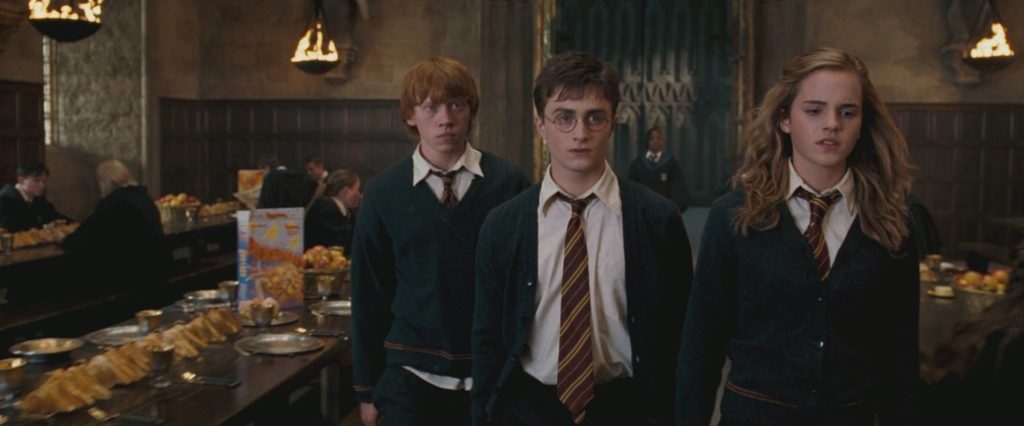
In 2005’s Harry Potter and the Goblet of Fire, the boy wizard’s already extraordinary life was dramatically altered as he witnessed the bodily return of You Know Who (Voldemort) and the death of one of his schoolmates at the dark lord’s hand. Harry Potter and the Order of the Phoenix picks up where that tale left off, with Harry having terrible flashbacks of those events. And the terror isn’t only in his head.
Evidence is mounting that Voldemort is recruiting followers—building an army in an attempt to return to his former power. To keep pace, the Weasley parents, Sirius Black, Remus Lupin and other friends reunite the Order of the Phoenix, a society of “good” wizards created by Albus Dumbledore during Voldemort’s previous rise. The Ministry of Magic, however, prefers to bury its collective bureaucratic head in the sand and pretend that nothing unusual is happening. Harry and his mentor, Dumbledore, refuse to parrot the ministry’s version of the story, so they’re set up as mutineers. In retaliation for their supposed disloyalty, the ministry sends Dolores Umbridge to Hogwarts School of Witchcraft and Wizardry. Her sticky-sweet voice and perpetually pink wardrobe are just a cover for her dictatorial designs. In short order, she manages to oust Dumbledore and take over as headmistress.
Balking at Umbridge’s unconvincing assurances that the wizarding world is perfectly safe, Harry and his friends—as if to parallel the Order of the Phoenix—also create a secret society in which Harry teaches the others to defend themselves against the dark arts. As Harry’s flashbacks get stronger, they become interspersed with visions of what may (or may not) be happening in the present, in a dark room within the Ministry of Magic itself.
It’s there that a confrontation takes place that will bring the truth about Voldemort to light for the entire magical world.
Order of the Phoenix is largely a lesson in civil disobedience, and ethically, the film handles itself pretty well on that subject. The government is indeed trying to deceive the citizens of the wizarding world. Harry and his friends (teens and adults alike) set out to bring the truth to light, even if it means acting contrary to the decrees of the Ministry of Magic. When Harry is subjected to a kangaroo court that threatens to expel him from Hogwarts, Arthur Weasley reassures him that he hasn’t done anything wrong and that the truth will prevail. In addition, the film sends a message that action is important, as opposed to the wishy-washy stance on evil taken by the Ministry of Magic.
Ever-present in the Harry Potter stories are the themes of loyalty and friendship. This time, Harry is struggling with loneliness and isolation because the Ministry of Magic has made him out to be a liar. A classmate rebukes Harry for giving in to these feelings: “If I were [Voldemort], I’d want you to feel cut off from everyone else. ‘Cause if it’s just you alone, you’re not as much of a threat.”
Harry may not buy it yet, but his friends Ron and Hermione continually stick with him and stand up for him throughout the film. And Sirius reassures him that once the danger has passed, he will take the permanent role of Harry’s adopted dad. In the end, Harry learns that it’s the love and support of his friends—and his ability to love them back—that makes him victorious over Voldemort.
By now, there’s nothing new under the sun when it comes to the use of magic in the Harry Potter series of books and movies. It is taken for granted that there are good wizards and bad wizards, and that they all use spells, potions and incantations. In addition, magical inventions make everyday life easier in the wizarding world: a special powder makes travel from one fireplace to another possible; Ron Weasley’s twin brothers create “extendable ears” to facilitate eavesdropping. When apparating—simply appearing at one’s desired destination—isn’t possible, invisible flying horses called thestrals help out with transportation, as do the traditional brooms. Mail doesn’t need to be read because it reads itself out loud. A few taps on the sidewalk with a broomstick cause the buildings at Grimmauld Place to shift, revealing the headquarters of the Order of the Phoenix.
Central is Harry’s advent as an instructor of his peers in defense against the dark arts. (Since Umbridge prefers “theoretical learning” in a “risk-free environment,” Harry and his friends take the practical side of magic into their own hands.) They are repeatedly shown practicing spells to stun and disarm one another. On a far more serious level, Dumbledore recruits Snape to teach Harry occlumency—the magical art of closing one’s mind to anyone who might be trying to read it or control it. This tutelage figures prominently into the film’s final battle.
Even with all the magic in the air, the worldview of Phoenix can’t be called consistently occult. Like the world we live in today, it’s a hodgepodge of ideas that are accepted simultaneously, even if they don’t really fit together. Students repeatedly wish each other “Merry Christmas” before their school holiday begins. At one point, Snape tells Harry to pray, with no reference to whom he should pray to. And much of the magic in the film is arguably “mechanical,” lending support to a naturalistic philosophy.
Humanism also gets its share of screen time. Generalized (and secularized) moralizing includes statements from Harry’s godfather, Sirius, who tells him, “You’re not a bad person, Harry. You’re a very good person whom bad things have happened to. … We’ve all got both light and dark inside of us. What matters is the part we choose to act on. That’s who we really are.” Similarly, Harry tells his friends, “Working hard is important, but there’s something more important: believing in yourself.”
But that battle beginning to rage within Harry between what Sirius calls light and dark sometimes takes on more poignancy. When Harry feels like he’s becoming more and more like Voldemort as his visions and nightmares increase, for instance, he’s wisely urged to concentrate on the things that make them different, not the things that seem to be drawing them together.
Dudley mockingly asks Harry if Cedric Diggory (the boy who died at the end of Goblet) is Harry’s boyfriend. Harry and Cho Chang share a fairly lengthy kiss under magical mistletoe. When asked by Ron to describe the experience, Harry simply responds, “Wet.” Ron makes a crack about “snogging.” Bellatrix bares cleavage while fighting at Voldemort’s side.
Because Voldemort is becoming a more formidable threat, the stakes are getting higher. Professor Moody warns the members of the Order, “Don’t break ranks if one of us gets killed.” In one of Harry’s visions, Arthur Weasley is attacked and almost killed. We don’t see what’s attacking him because, disturbingly, Harry takes the point of view of the attacker in his vision. The extensive damage and pain (and one death) inflicted by the final face-off in the halls of the Ministry involves thrown lightning, dragons made of fire, a swirling ball of water and a million shards of glass, all conjured by wizards’ wands.
The effects of Harry’s traumatic triumph in Goblet’s Triwizard Tournament are evident when Harry can see the creatures that pull the carriages at Hogwarts. Before this, they’d been invisible to him because he hadn’t yet witnessed a death. Also, the nastiness beneath Umbridge’s syrupy exterior surfaces when she forces Harry to write, “I must not tell lies,” with a quill that cuts the words into his own flesh.
The film opens with Harry’s brutish cousin Dudley menacing him again. Harry asks the 16-year-old Dudley if he’s just beat up another 10-year-old, to which Dudley responds in the affirmative. In a swift turn of the tables, Dudley soon finds himself passed out on the ground at the hands of a creepy dementor (a magical prison guard whose greatest weapon is the ability to suck the souls out of men).
Teenage scuffles continue at Hogwarts, where Draco Malfoy taunts Harry, who lunges at him, but is restrained by Ron. Snape cracks Ron on the back of the head with a book for disrupting his class. Umbridge viciously slaps Harry across the face. A student who has been magically raised into the air by another student’s spell crashes to the ground.
Ron is still fond of the expression “bloody h—,” but he tones it down to a couple uses this time. “Bloody” is also paired with “idiot.” “Good lord” and “for god’s sake” pop up, as do “blimey,” “nutter” and “b-gger off.” Slurs and insults include “stupid,” “freak,” “hag,” “half-breed,” “half-blood” and “mudblood.”
None.
Fred and George Weasley are up to their usual tricks, creating magical candy that will make students just sick enough to get out of class and disrupting exams with a fireworks show that they know will get them expelled. The twins also make a bet regarding the results of a practice magical duel between Ron and Hermione. Ron tells Hermione, “I hate you,” and he’s only half-joking.
It’s movie No. 5. How much more information do you need? What is there left to say? Under new director David Yates, Harry Potter and the Order of the Phoenix maintains the visual beauty and wonder of the first four installments of this franchise. And Yates’ approach allows him to focus on the high points of the plot, resulting in a more comfortably paced movie than Goblet of Fire.
Unexpectedly, Yates doesn’t seem to be interested in emphasizing the fact that the Potter crew is growing up and thus becoming more rebellious and hormonal: He touches on, but doesn’t dwell on, Harry’s relationship with Cho Chang. The language is slightly milder than in the previous film. And though there are several instances of disobedience, they fall almost entirely under the heading of civil disobedience discussed above, so they’re not as problematic as in previous iterations.
But it’s now that audiences discover for sure (as if they didn’t know already) that the rivalry between Harry Potter and Lord Voldemort will eventually lead to one of them killing the other. And as the conflict makes its way toward that mortal end, violence dogs its path. Though the film version of Phoenix is not as gloomy as the book, the story presented therein is still far too severe to justify the affections of its primary fans: kids. And that’s true without even mentioning the ongoing dilemma presented by the omnipresence of magic and the clash with the real-life truth that there is no such thing as a good witch or wizard.
